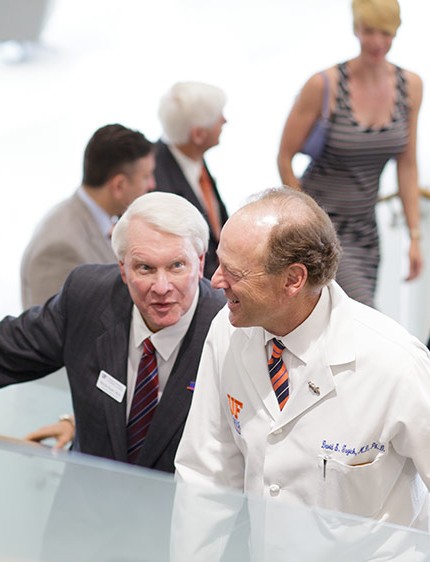It was Sunday, three days before the George T. Harrell, MD, Medical Education Building was to officially open for classes, and students could be found in just about every corner of its four floors.
Second-year medical students wallpapered the inside of the new lockers with contact paper and other embellishments — a surprise for their “littles” from the incoming first-year class. Small groups of physician assistant students, dressed in blue PA T-shirts, gathered in stylish workstations and comfortable chairs with propped-open laptops.
“Every room you look in, you see a student,” said Michael L. Good, dean of the UF College of Medicine, as he toured the new building that Sunday to examine its finishing touches. “They couldn’t wait to move in, and I can’t blame them. It’s an extraordinary facility, and it was designed for them.”
The 95,000-square-foot Harrell Medical Education Building is the UF College of Medicine’s first “true home” in its 59-year history, and it is a dream come true for the many who labored over the project for more than five years. The building, named after the college’s visionary founding dean, was carefully designed to accommodate the UF College of Medicine’s modern curriculum and innovative teaching tools.
“Nearly three years before we broke ground on this facility, we explored new territory and created a patient-centered approach to medical education,” Good said. “We went from passive learning — absorbing knowledge in a large-scale environment with little opportunity to apply it — to active, team-based learning in small groups.”

Alexis Boulter, left, and Nikita Patel, first-year medical students, enjoy the festivities at the Harrell Medical Education Building dedication July 29. The action-packed day was also the first day of medical school for the class of 2019. Photo by Mindy C. Miller
Good explained that the strategic planning process launched in 2009 by David S. Guzick, MD, PhD, senior vice president for health affairs at UF and president of UF Health, outlined the need for a new medical education building as part of the framework for the future of the entire academic health center.
“Dr. Guzick’s endorsement and advocacy for this new facility helped catapult it from an outline to the stunning structure you see today,” Good said.
The $46 million Harrell Medical Education Building includes spaces for just about every approach to learning — quiet independent-study lounges, semi-quiet rooms for collaborative learning and the Florence Pavlik and Joseph Rush, MD, Student Lounge, furnished with a ping-pong table to help ease the rigors of medical school. More than a dozen collaborative learning spaces throughout the building accommodate class sizes starting at four and going up to six, 12, 20 and even 70.
Outside, the Alan H. Porter, MD, and Claudia B. Porter, RN, Tower gives the exterior its signature look, and the two-story Steven M. Scott, MD, and Rebecca J. Scott Commons provides the building’s striking entrance. Two 4,600-square-feet circular learning studios are located on opposite sides of the commons, and the H. James Free, MD, Center for Primary Care Education and Innovation sits to the northwest of the commons.
The top two floors of the building are dedicated to hands-on experiences, with 18 standardized patient examination rooms, two hospital rooms and several classrooms in the Dr. Angelo and Alberta Anaclerio Learning and Assessment Center. The state-of-the-art Lou Oberndorf Experiential Learning Theater on the fourth floor can be configured to represent hundreds of simulated health care scenarios to help bring clinical situations to life and teach students, residents and health care professionals new and complex skills.

Isabel Lei-Pardo tours the Harrell Medical Education Building during the dedication July 29. Lei-Pardo and her husband, Dr. Rube Pardo, a graduate from the class of 1985, were Alumni Challenge participants. Photo by Mindy C. Miller
The building is also home to the UF School of Physician Assistant Studies, with the Randolph B. Mahoney, PA, School of Physicians Assistant Studies Suite located on the fourth floor.
“This building reaffirms our love for teaching and commitment to students as the central pillar of our university,” said UF President Kent Fuchs during the Harrell Medical Education Building dedication ceremony July 29.
Guzick said the Harrell Medical Education Building exemplifies how to design a space around a forward-looking curriculum.
“It is a true home to the innovative education that has always defined the University of Florida,” he said, “and will provide an identity that our students and faculty can be proud of as they set the standard for medical education.”

Dr. Steven M. Scott, left, chair of the UF Board of Trustees, and Dr. David S. Guzick, senior vice president for health affairs at UF and president of UF Health, walk together during the building dedication for the Harrell Medical Education Building. Photo by Mindy C. Miller
While the late-afternoon dedication ceremony outside the Harrell Medical Education Building was abruptly cut short due to a sudden downpour, the summer thunderstorm didn’t spoil the building’s debut. Hundreds of guests toured the facility and enjoyed the fresh new look of medical education at UF — including the 135 first-year medical students at the end of their long but exciting first day of medical school.
“We knew we would start in a brand new building, but this has surpassed anything we could have imagined,” said Shelby Goicochea, a first-year UF medical student. “You notice right away all the planning that went into the design — with plugs everywhere for laptops, lots of study spaces and natural lighting.”
Once on the second floor, the new students made a beeline for their lockers and discovered each was personalized to their tastes by their “big sibs” from the second-year class.
“Now we know why they asked us so many questions — like our favorite color,” Goicochea said. “This entire day reaffirms that we are a big family at the UF College of Medicine.”


